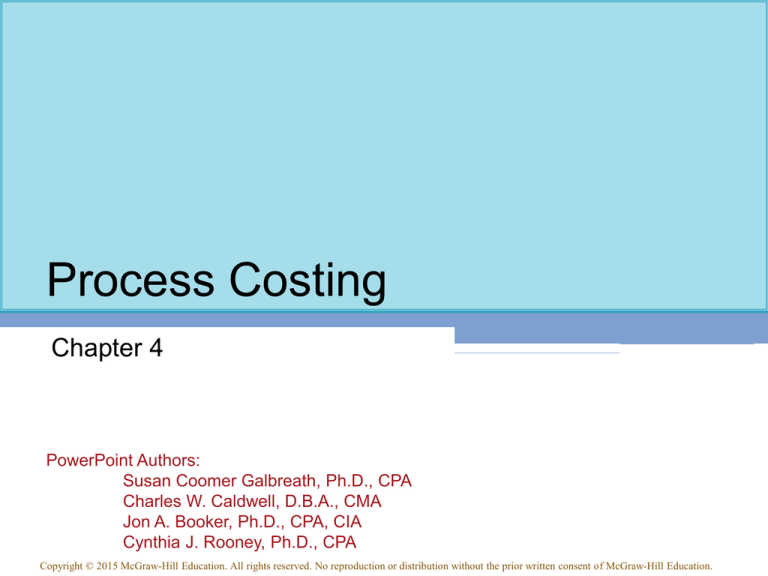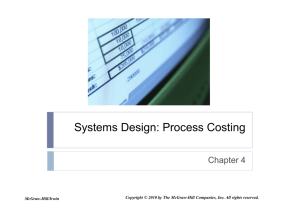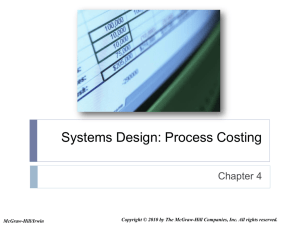
Process Costing
Chapter 4
PowerPoint Authors:
Susan Coomer Galbreath, Ph.D., CPA
Charles W. Caldwell, D.B.A., CMA
Jon A. Booker, Ph.D., CPA, CIA
Cynthia J. Rooney, Ph.D., CPA
Copyright © 2015 McGraw-Hill Education. All rights reserved. No reproduction or distribution without the prior written consent of McGraw-Hill Education.
4-2
Similarities Between Job-Order and
Process Costing
• Both systems assign material, labor, and overhead
costs to products and they provide a mechanism
for computing unit product costs.
• Both systems use the same manufacturing
accounts, including Manufacturing Overhead, Raw
Materials, Work in Process, and Finished Goods.
• The flow of costs through the manufacturing
accounts is basically the same in both systems.
4-3
Differences Between Job-Order and
Process Costing
Process costing:
1. Is used when a single product is produced on a
continuing basis or for a long period of time. Job-order
costing is used when many different jobs having
different production requirements are worked on each
period.
2. Systems accumulate costs by department. Job-order
costing systems accumulated costs by individual jobs.
3. Systems compute unit costs by department. Job-order
costing systems compute unit costs by job on the job
cost sheet.
4-4
Processing Departments
Any unit in an organization where materials, labor,
or overhead are added to the product.
The activities performed in a processing
department are performed uniformly on all
units of production. Furthermore, the output of
a processing department must be homogeneous.
Products in a process costing environment typically
flow in a sequence from one department to another.
4-5
The Flow of Materials, Labor, and
Overhead Costs
Direct
Materials
Direct Labor
Manufacturing
Overhead
Work in
Process
Finished
Goods
Cost of
Goods
Sold
4-6
The Flow of Costs in a Job-Order
Costing System
Costs are traced and
applied to individual
jobs in a job-order
cost system.
Direct
Materials
Direct Labor
Manufacturing
Overhead
Jobs
Finished
Goods
Cost of
Goods
Sold
4-7
The Flow of Costs in a Processing
Costing System
Direct
Materials
Direct Labor
Manufacturing
Overhead
Costs are traced and
applied to departments
in a process cost
system.
Processing
Department
Finished
Goods
Cost of
Goods
Sold
4-8
T-Account and Journal Entry Views of
Process Cost Flows
For purposes of this example, assume there
are two processing departments –
Departments A and B.
We will use T-accounts and journal entries.
4-9
Process Cost Flows: The Flow of Raw
Materials (in T-account form)
Raw Materials
•Direct
Materials
Work in Process
Department A
•Direct
Materials
Work in Process
Department B
•Direct
Materials
4-10
Process Cost Flows: The Flow of Labor
Costs (in T-account form)
Salaries and
Wages Payable
•Direct
Labor
Work in Process
Department A
•Direct
Materials
•Direct
Labor
Work in Process
Department B
•Direct
Materials
•Direct
Labor
4-11
Process Cost Flows: The Flow of Manufacturing
Overhead Costs (in T-account form)
Work in Process
Department A
Manufacturing
Overhead
•Actual
Overhead
•Overhead
Applied to
Work in
Process
•Direct
Materials
•Direct
Labor
•Applied
Overhead
Work in Process
Department B
•Direct
Materials
•Direct
Labor
•Applied
Overhead
4-12
Process Cost Flows: Transfers from WIPDept. A to WIP-Dept. B (in T-account form)
Work in Process
Department A
•Direct
Transferred
Materials
to Dept. B
•Direct
Labor
•Applied
Overhead
Department
A
Work in Process
Department B
•Direct
Materials
•Direct
Labor
•Applied
Overhead
•Transferred
from Dept. A
Department
B
4-13
Process Cost Flows: Transfers from WIPDept. B to Finished Goods (in T-account form)
Work in Process
Department B
•Direct
•Cost of
Materials
Goods
•Direct
Manufactured
Labor
•Applied
Overhead
•Transferred
from Dept. A
Finished Goods
•Cost of
Goods
Manufactured
4-14
Process Cost Flows: Transfers from Finished
Goods to COGS (in T-account form)
Work in Process
Department B
Finished Goods
•Direct
•Cost of
•Cost of
•Cost of
Materials
Goods
Goods
Goods
•Direct
Manufactured
Manufactured
Sold
Labor
•Applied
Overhead
•Transferred
Cost of Goods Sold
from Dept. A
•Cost of
Goods
Sold
4-15
Equivalent Units of Production
Equivalent units are the
product of the number
of partially completed
units and the
percentage completion
of those units.
These partially completed units complicate the
determination of a department’s output for a given
period and the unit cost that should be assigned to
that output.
4-16
Equivalent Units – The Basic Idea
Two half completed products are
equivalent to one complete product.
+
=
1
So, 10,000 units 70% complete
are equivalent to 7,000 complete units.
4-17
Treatment of Direct Labor
Dollar Amount
Direct
Materials
Manufacturing
Overhead
Direct
Labor
Type of Product Cost
Direct labor costs
may be small
in comparison to
other product
costs in process
cost systems.
4-18
Treatment of Direct Labor
Dollar Amount
Direct
Materials
Conversion
Direct
Labor
Direct
Labor
Type of Product Cost
Manufacturing
Overhead
Direct labor and
manufacturing
overhead may be
combined into
one classification
of product
cost called
conversion costs.
4-19
Compute and Apply Costs
The formula for computing the cost per equivalent
unit is:
Cost per
equivalent =
unit
Cost of beginning
Work in Process + Cost added during
Inventory
the period
Equivalent units of production
4-20
Operation Costing
Operation cost is a hybrid of job-order and
process costing because it possesses
attributes of both approaches.
Operation costing is
commonly used when
batches of many
different products pass
through the same
processing department.
4-21
End of Chapter 4


